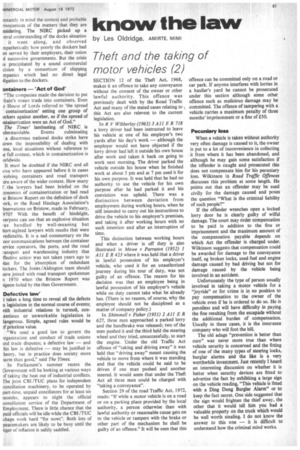know the law
Page 53

If you've noticed an error in this article please click here to report it so we can fix it.
by Les Oldridge, AMIRTE, MIMI
Theft and the taking of motor vehicles (2)
SECTION 12 of the Theft Act, 1968, makes it an offence to take any conveyance without the consent of the owner or other lawful authority. This offence was previously dealt with by the Road Traffic Act and many of the stated cases relating to \ this Act are also relevent to the current legislation.
In R V Wibberley (1965) 3All ER 718 a lorry driver had been instructed to leave his vehicle at one of his employer's two yards after his day's work — although the employer would not have objected if the lorry driver had left it outside his own house after work and taken it back on going to work next morning. The driver parked the vehicle outside his house when he finished work at about 5 pm and at 7 pm used it for his own purpose. It was held that he had no authority to use the vehicle for his own purpose after he had parked it and his conviction was upheld. There was a distinction between deviation from employment during working hours, when he still intended to carry out his instructions to drive the vehicle to his employer's premises, and taking it after working hours with no such intention and after an interruption of time.
This distinction between working hours and when a driver is off duty is also illustrated in Mowe v Parraton (1952) I All ER 423 where it was held that a driver in lawful possession of his employer's vehicle, who used it for an unauthorized journey during his tour of duty, was not guilty of an offence. The reason for his decision was that an employee being in lawful possession of his employer's vehicle while on duty cannot take what he already has. (There is no reason, of course, why the employee should not be disciplined as a matter of company policy.) In Shimmell v Fisher (1951) 2 All E R 627, three men approached a parked lorry and the handbrake was released; two of the men pushed it and the third held the steering wheel and they tried, unsuccessfully, to start the engine. Under the old Traffic Act offence of "taking and driving away" it was held that "driving away" meant causing the vehicle to move from where it was standing and that the vehicle could be said to be driven if one man pushed and another steered. It would seem that under the Theft Act all three men could be charged with "taking a conveyance".
Section 29 of the road Traffic Act, 1972, reads: "If while a motor vehicle is on a road or on a parking place provided by the local authority, a person otherwise than with lawful authority or reasonable cause gets on to the vehicle or tampers with the brake or other part of the mechanism he shall be guilty of an offence." It will be seen that this offence can be committed only on a road or car park. If anyone interferes with lorries in a haulier's yard he cannot be prosecuted under this section although some other, offence such as malicious damage may be committed. The offence of tampering with a vehicle carries a maximum penalty of three months' imprisonment or a fine of £50.
Pecuniary loss When a vehicle is taken without authority very often damage is caused to it, the owner is put to a lot of inconvenience in collecting it from where it has been abandoned, and although he may gain some satisfaction if the offender is caught and prosecuted this does not compensate him for his pecuniary loss. Wilkinson in Road Traffic Offences discusses this problem at some length. He points out that an offender may be sued civilly for the damage caused and poses the question "What is the criminal liability of such people?"
If the offender wrenches open a locked lorry door he is clearly guilty of wilful damage. The court may order compensation to be paid in addition to the fine or imprisonment and the maximum amount of the compensation payable depends on which Act the offender is charged under. Wilkinson suggests that compensation could be awarded for damage to the conveyance itself, eg broken locks, used fuel and engine damage caused by bad driving but not for damage caused by the vehicle being involved in an accident.
Unfortunately the type of person usually involved in taking a motor vehicle for a "joyride" or for crime is in no position to pay compensation to the owner of the vehicle even if he is ordered to do so. He is penniless and will have difficulty in paying the fine resulting from the escapade without the additional burden of compensation. Usually in these cases, it is the insurance company who will foot the bill.
The old adage "prevention is better than cure" was never more true than where vehicle security is concerned and the fitting of one of the many types of steering locks, burglar alarms and the like is a very worthwhile investment. Just recently I heard an interesting discussion on whether it is better when security devices are fitted to advertise the fact by exhibiting a large sign on the vehicle reading, "This vehicle is fitted with a Ding Doug Burglar Alarm" or to keep the fact secret. One side suggested that the sign would frighten the thief away, the other that it would tell him you had a valuable property on the truck As/hich wOuld be well worth stealing. I do not know the answer to this one — it is difficult to understand how the criminal mind works.


































































































